Has science taken a wrong turn? If so, what corrections are needed? Chronicles of scientific misbehavior. The role of heretic-pioneers and forbidden questions in the sciences. Is peer review working? The perverse "consensus of leading scientists." Good public relations versus good science.
Moderators: MGmirkin, bboyer
-
StefanR
- Posts: 1371
- Joined: Sun Mar 16, 2008 8:31 pm
- Location: Amsterdam
Unread post
by StefanR » Tue May 06, 2008 12:00 pm
Superfluidity is a phase of matter or description of heat capacity in which unusual effects are observed when liquids, typically of helium-4 or helium-3, overcome friction by surface interaction when at a stage, known as the "lambda point" for helium-4, at which the liquid's viscosity becomes zero. Also known as a major facet in the study of quantum hydrodynamics, it was discovered by Pyotr Kapitsa, John F. Allen, and Don Misener in 1937 and has been described through phenomenological and microscopic theories.
Background
Although the phenomenologies of the superfluid states of helium-4 and helium-3 are very similar, the microscopic details of the transitions are very different. Helium-4 atoms are bosons, and their superfluidity can be understood in terms of the Bose statistics that they obey. Specifically, the superfluidity of helium-4 can be regarded as a consequence of Bose-Einstein condensation in an interacting system. On the other hand, helium-3 atoms are fermions, and the superfluid transition in this system is described by a generalization of the BCS theory of superconductivity. In it, Cooper pairing takes place between atoms rather than electrons, and the attractive interaction between them is mediated by spin fluctuations rather than phonons. See fermion condensate. A unified description of superconductivity and superfluidity is possible in terms of gauge symmetry breaking.
Superfluids, such as supercooled helium-4, exhibit many unusual properties. A superfluid acts as if it were a mixture of a normal component, with all the properties associated with normal fluid, and a superfluid component. The superfluid component has zero viscosity, zero entropy, and infinite thermal conductivity. (It is thus impossible to set up a temperature gradient in a superfluid, much as it is impossible to set up a voltage difference in a superconductor.) One of the most spectacular results of these properties is known as the thermomechanical or "fountain effect". If a capillary tube is placed into a bath of superfluid helium and then heated, even by shining a light on it, the superfluid helium will flow up through the tube and out the top as a result of the Clausius-Clapeyron relation. A second unusual effect is that superfluid helium can form a layer, a single atom thick, up the sides of any container in which it is placed.
A more fundamental property than the disappearance of viscosity becomes visible if superfluid is placed in a rotating container. Instead of rotating uniformly with the container, the rotating state consists of quantized vortices. That is, when the container is rotated at speed below the first critical velocity (related to the quantum numbers for the element in question) the liquid remains perfectly stationary. Once the first critical velocity is reached, the superfluid will very quickly begin spinning at the critical speed. The speed is quantized - i.e. it can only spin at certain speeds.
Applications
Recently in the field of chemistry, superfluid helium-4 has been successfully used in spectroscopic techniques, as a quantum solvent. Referred to as Superfluid Helium Droplet Spectroscopy (SHeDS), it is of great interest in studies of gas molecules, as a single molecule solvated in a superfluid medium allows a molecule to have effective rotational freedom - allowing it to behave exactly as it would in the "gas" phase.
Superfluids are also used in high-precision devices, such as gyroscopes, which allow the measurement of some theoretically predicted gravitational effects (for an example see the Gravity Probe B article).
Recently, superfluids have been used to trap light and slow its speed. In an experiment, performed by Lene Hau, light was passed through a superfluid and found to be slowed to 17 metres per second from its normal speed of 299,792,458 metres per second in vacuum.[1] This does not change the absolute value of c, nor is it completely new: any medium other than vacuum, such as water or glass, also slows down the propagation of light in a certain fraction.
The Infrared Astronomical Satellite (IRAS), launched in January 1983 to gather infrared data was cooled by 720 litres of superfluid helium, maintaining a temperature of 1.6K (-271.6 °C).
http://en.wikipedia.org/wiki/SuperfluidThe illusion from which we are seeking to extricate ourselves is not that constituted by the realm of space and time, but that which comes from failing to know that realm from the standpoint of a higher vision. -L.H.
-
StefanR
- Posts: 1371
- Joined: Sun Mar 16, 2008 8:31 pm
- Location: Amsterdam
Unread post
by StefanR » Tue May 06, 2008 12:02 pm
Helium theory
Largest part of the Helium theory work is devoted to investigating the properties of the superfluid 3He. Why this is interesting, is explained here.
There is a short introduction to the following topics.
* helium
* superfluid 3He
* superfluidity and quantized vortices
* vortices in superfluid 3He
Some active projects are described in more detail below.
* Twisted vortex states in superfluids
Here are some finished projects.
* Dissipation in superfluid 3He weak links
* π state (pi state) in 3He Josephson junctions
* Superfluid 3He in aerogel
* NMR and solitons in superfluid 3He
* Vortex sheet on the A-B interface of 3He
* Vortex sheet in superfluid 3He-A
* Hydrostatic theory of 3He-B
* Critical velocity of superfluid 3He-A
* Defect formation in inhomogeneous normal-superfluid transition
* Facets of 4He crystals
* Phase diagram of vortices in superfluid 3He-A
Transparencies of recent presentations
* Recent topics in the theory of superfluid 3He, (13.5.2003, E. Thuneberg, pdf file, 1 Mb)
* Vortex sheets and solitons in superfluid 3He-A, (14.5.2003, E. Thuneberg, pdf file, 456 kb)
* Vortices at the A-B phase boundary in superfluid 3He, (17.5.2003, R. Hänninen, pdf file, 3 Mb)
http://ltl.tkk.fi/research/theory/heliumtheory.html
Why to study superfluid 3He?
I am interested in superfluid 3He because it is one of a small number of systems that satisfy all the following conditions.
* It exists in nature.
* One can study it experimentally. The experimental results can be reproduced.
* It shows nontrivial phenomena. In fact, there is a great number of them.
* There exists a powerful theory which provides quantitative understanding for most experimental results and predicts many phenomena. This is the quasiclassical theory of Fermi liquids.
I believe that superfluid 3He is a paradigm that is useful for other branches of physics, especially for unconventional superconductivity.
The illusion from which we are seeking to extricate ourselves is not that constituted by the realm of space and time, but that which comes from failing to know that realm from the standpoint of a higher vision. -L.H.
-
StefanR
- Posts: 1371
- Joined: Sun Mar 16, 2008 8:31 pm
- Location: Amsterdam
Unread post
by StefanR » Tue May 06, 2008 12:08 pm
Superfluidity and Quantized Vortices
We are all familiar with vortices in fluids, for example, in a river when the water becomes turbulent after it has passed an obstacle, or in an emptying bath tube. A somewhat different case occurs in a glass of water that is placed on a rotating turn-table. After some initial slowness, the water starts to rotate uniformly with the glass. By definition, vorticity is also present in the uniform rotation because the flow velocity at the edges is larger than in the center.
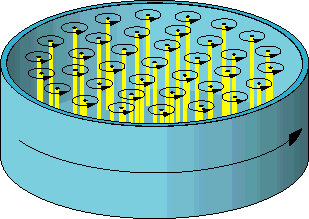
There is a special class of fluids that are called superfluids. Superfluids have the property that they can flow through narrow channels without viscosity. However, more fundamental than the absence of dissipation is the behavior of superfluids under rotation. In contrast to the example of a glass of water above, the rotation in superfluids is always inhomogeneous (figure). The fluid circulates around quantized vortex lines. The vortex lines are shown as yellow in the figure, and the circulating flow around them is indicated by arrows. There is no vorticity outside of the lines because the velocity near each line is larger than further away. (In mathematical terms curl v = 0, where v(r) is the velocity field.)
The velocity around each vortex line is determined by h/m, where h is the Planck's constant, and m the mass of one atom. The presence of the Planck's constant means that quantized vorticity is a consequence of quantum mechanics. h is very small, but so is m, so the ratio h/m is quite macroscopic. Therefore, superfluidity is a quantum phenomenon on a macroscopic scale. The number of vortex lines depends on the constant h/m. There are approximately 1000 vortex lines in a container of radius 1 cm that is rotating 1 round per minute.
Superfluidity occurs only at low temperatures. The best known superfluids are the two isotopes of helium, 3He and 4He. Evidence of superfluidity has also been found in cold atomic gases. Related to superfluidity is superconductivity, which occurs in several metallic elements and compounds at low temperatures. Corresponding to the nonviscous flow in a superfluid, a superconductor can conduct resistanceless electric current. Vortex lines in a superfluid are analogous to flux lines which occur in a superconductor (of type II) when it is placed in a magnetic field. Superfluidity is also believed to occur inside neutron stars.
There are several different structures for vortices in superfluid 3He.
http://ltl.tkk.fi/research/theory/vortex.html
Vortices in Superfluid 3He
The first experiments on rotating superfluid 3He in Helsinki were made in the early 80's. They showed clear evidence that two different types of quantized vortices were present in the B phase [1]. The stability of the two depends on the temperature and pressure as indicated in the phase diagram (fig. 1). Theoretical calculations showed that both vortex types have spontaneously broken symmetry in the vortex core. In particular, the vortex that is stable at low pressures was identified with the double-core vortex, where the circular symmetry around the vortex axis is broken [2]. The amplitude of the order parameter in the cores of the two vortex lines (parallel to z) is illustrated in fig. 2. The split core of the double-core vortex can be interpreted as two half-quantum vortices. These are related to the π state in 3He Josephson junctions.
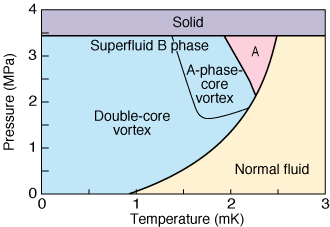
More definitely, the two vortices above should be called mass vortices because there is a mass flow around the vortex axis. In addition to mass vortices, 3He supports also spin vortices, where the spin-up condensate circles in opposite direction than the spin-down condensate. Such metastable structures have been seen experimentally after a transition from the A phase.
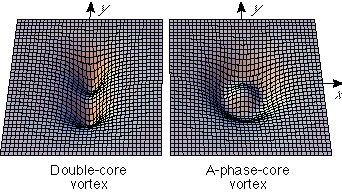
There are also several types of vortices in the A phase. Their stability depends only weakly on the pressure and temperature, but there is a crucial dependence on the rotation velocity and magnetic field.
See Ref. [3] for a review of vortices in superfluid 3He.
http://ltl.tkk.fi/research/theory/bvortex.html
Phase Diagram of Vortices in Superfluid 3He-A

We have made numerical calculations of the vortex structures in rotating superfluid 3He-A. We find six different types of periodic vortex structures, out of which five are shown here. The relative stability of the different vortices depends on the rotation velocity and the magnetic field, as shown in the phase diagram at middle left in the figure. The five vortex structures are illustrated by drawing the orbital (l, red) and spin (d, blue) anisotropy vectors in the x-y plane, perpendicular to the rotation axis z. The yellow shading denotes regions where the vorticity is concentrated, whereas the blue shading denotes regions without vorticity. Similar to vortices in superfluid 4He, the continuous unlocked vortex and the singular vortex have a line structure. The vortex sheet and the locked vortex 3 are 2-dimensional objects. In the locked vortex 1 the vorticity is nonzero everywhere. NMR experiments have identified four of the structures: the difference between the locked vortices has still escaped experimental observation. The measured phase diagram is in semiquantitative agreement with theoretical calculations.
The vortices are created in a rotating container when the critical velocity is exceeded.
http://ltl.tkk.fi/research/theory/diagram.html
Vortex Sheet in Superfluid 3He-A
A new state of rotating superfluid 3He-A has been found experimentally and explained theoretically. Usually superfluids respond to rotation by creating an array of vortex lines. The lines are parallel to the rotation axis, and the circulation around them is quantized. The new state consists of a vortex sheet, where the vorticity is located on a 2 dimensional sheet instead of 1 D lines. In contrast to other superfluids, the sheet is stable in the A phase because of its internal structure. The sheet has as a backbone a topologically stable domain wall called soliton. Non-singular vorticity is then bound to the soliton. The structure of the vortex sheet is calculated by means of variational approximations. This allows calculation of the frequency shifts and the amplitudes of NMR satellite peaks. The calculations are in good agreement with experiments. The vortex sheet is one out of six different vortex types in superfluid 3He-A.
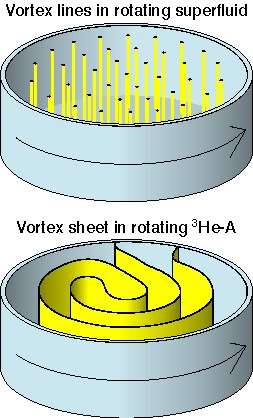
In a rotating container the vortex sheet is parallel to the rotation axis z but in the x-y plane it folds to equidistant layers. The distance between the layers is larger but on the same order of magnitude as the distance between vortex lines. The folding of the vortex sheet is studied by numerical simulations. The lines where the vortex sheet touches the side wall are essential for the response of the sheet to changes in the rotation velocity. The figure here has only one sheet and two connection lines. By modulating the rotation velocity it is possible to create a state that has more connection lines, and thus faster response to changes in the rotation velocity.
A different type of vortex sheet occurs on the interface of A and B phases.
http://ltl.tkk.fi/research/theory/sheet.html
Twisted vortex state
Consider superfluid in a long cylindrical container. The container is rotating around its axis, but we assume that there are no vortices in the initial state. If vortices are then generated at one end, they start to propagate along the cylinder. Simultaneously the vortex ends rotate around the cylinder axis. For the propagating ends this rotation is slower than for the equilibrium vortex lattice, which tends to rotate at the same angular velocity as the container. This creates a twisted vortex state, as shown in the figure.
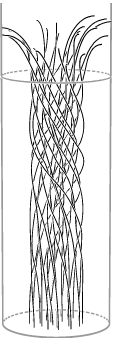
In the publication we present simple arguments for the difference in the rotation velocity. We construct a continuum theory for the twist and find equations governing the untwisting. The twisted state gives rise to axial supercurrents. We report experimental evidence of the twisted state observed by NMR in superfluid 3He. Although not all details are understood, the measured relaxation time of the twisted state is in agreement with theoretical calculations.
Movies of twisted vortices
The figure on this page is a snapshot of the evolution of the vortex state. The whole evolution is shown in the following movie: twist with 23 vortices (3.4M). All movies are based on accurate numerical solution of the vortex equations of motion.
In addition to vortices, the following movie shows also the axial and azimuthal counterflow velocities: axial and azimuthal velocities (5.3M).
More movies of twisted vortices
http://ltl.tkk.fi/research/theory/twist.htmlThe illusion from which we are seeking to extricate ourselves is not that constituted by the realm of space and time, but that which comes from failing to know that realm from the standpoint of a higher vision. -L.H.
-
StefanR
- Posts: 1371
- Joined: Sun Mar 16, 2008 8:31 pm
- Location: Amsterdam
Unread post
by StefanR » Tue May 06, 2008 12:13 pm
VORTICES IN
SUPERFLUID 3He
Content
Introduction to superfluid 3He
Vortices in superfluid B phase
Vortices in superfluid A phase
Conclusions
Superfluidity
Superfluids can flow without friction.
Superfluidity is a quantum phenomenon on a macroscopic scale.
Macroscopic number of particles is in the same quantum state.
⇒ a macroscopic wave function (order parameter)
Bosons
A macroscopic number of bosons is in the same quantum state.
⇒ superfluidity of liquid 4He and gases of alkali atoms
Fermions
Only one fermion can occupy one quantum state.
Fermions form pairs (Cooper pairs).
⇒ superconductivity of metals, superfluidity of liquid 3He
Conclusion
Vorticity in superfluid 3He forms a very rich system because of the several
length scales that are relevant in this system.
http://ltl.tkk.fi/research/theory/Trans ... s/Kevo.pdfThe illusion from which we are seeking to extricate ourselves is not that constituted by the realm of space and time, but that which comes from failing to know that realm from the standpoint of a higher vision. -L.H.
-
StefanR
- Posts: 1371
- Joined: Sun Mar 16, 2008 8:31 pm
- Location: Amsterdam
Unread post
by StefanR » Tue May 06, 2008 12:18 pm
TWISTED VORTEX STATE
Content
1) Does the twisted state exist at all?
Hydrodynamic theory
- uniform twist
- linear theory of nonuniform twist
2) Generation of twisted vortex states
Numerical simulations
3) Observation in superfluid 3He
Summary of two opposite limits
Parallel plates
- columnar vortices
Long cylinder
- twisted vortices
2) Generation of twisted vortex states
- superfluid in a cylinder
- cylinder rotating at
but no vortices in the initial state
- generate vortices at one place
- vortices propagate along the
cylinder and
- vortex ends rotate around the
cylinder axis
Main observations
- the twisted state has axial current.
- individual vortices become unstable to generate Kelvin waves at
large axial current
- the vortices glide at the bottom plate
) relaxation of the twist
- the relaxation is determined by the diffusion equation.
Conclusions
Twisted vortex state is a possible state in long rotating cylinders.
The twisted state can be generated by vortex injection.
The twisted state has been seen in superfluid 3He-B.
http://ltl.tkk.fi/research/theory/Trans ... salemN.pdfThe illusion from which we are seeking to extricate ourselves is not that constituted by the realm of space and time, but that which comes from failing to know that realm from the standpoint of a higher vision. -L.H.
Who is online
Users browsing this forum: No registered users and 5 guests





